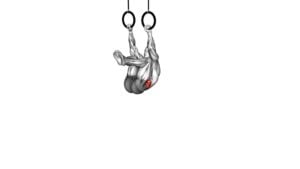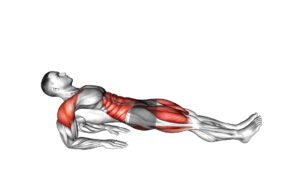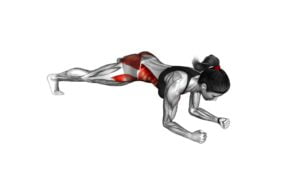Hanging Knees to Elbows – Video Exercise Guide & Tips

Are you looking to strengthen your core and improve your upper body strength? Look no further than hanging knees to elbows!
Watch This Exercise Video
This exercise targets your abs, obliques, and arms, giving you a full-body workout.
With just a pull-up bar as equipment, you can easily incorporate this exercise into your routine.
In this article, we'll guide you through proper form and technique, offer variations and progressions, and share common mistakes to avoid.
Get ready to take your fitness to the next level with hanging knees to elbows!
Key Takeaways
- Hanging Knees to Elbows targets abs, obliques, and arms.
- It provides a full-body workout and builds upper body strength.
- Proper form and technique are crucial, avoiding swinging or using momentum.
- Engaging the core throughout the movement is essential for building core strength.
Benefits of Hanging Knees to Elbows
To maximize your workout and strengthen your core, incorporate the benefits of hanging knees to elbows. This exercise is highly effective in building upper body strength and improving flexibility.
By hanging from a bar and bringing your knees up towards your elbows, you engage your core muscles, including your abs, obliques, and hip flexors. This movement not only targets your upper body but also helps to activate your lower body muscles, including your glutes and quadriceps.
Hanging knees to elbows is a compound exercise that challenges multiple muscle groups simultaneously. It requires coordination, balance, and stability, making it a great exercise for overall functional fitness. As you lift your knees towards your elbows, you develop strength in your upper body, particularly in your arms, shoulders, and back. This exercise also helps to lengthen and stretch your muscles, promoting improved flexibility.
To perform hanging knees to elbows, all you need is a sturdy overhead bar or a pull-up bar. This equipment allows you to hang freely, giving you the freedom of movement required for this exercise.
Now that you understand the benefits of hanging knees to elbows, let's move on to the equipment needed for this exercise.
Equipment Needed for Hanging Knees to Elbows
To successfully perform Hanging Knees to Elbows, there are a few essential pieces of equipment you'll need. These include a pull-up bar or suspension trainer, which will provide the necessary support for your body weight. However, if you don't have access to these, there are alternative options such as using a sturdy doorframe or a set of gymnastic rings.
Additionally, it's important to know how to modify the equipment to suit your individual needs and abilities.
Essential Equipment for Hanging Knees to Elbows
You will need a set of hanging knee sleeves to properly perform the exercise. These sleeves provide support and protection to your knees while hanging, reducing the risk of injury.
In addition to knee sleeves, there are a few other pieces of equipment that are essential for hanging knees to elbows:
- Pull-up bar: A sturdy and secure pull-up bar is necessary for this exercise. Make sure to choose a bar that can support your body weight.
- Grips: Investing in a pair of quality grips will improve your grip strength and reduce the strain on your hands and wrists during the exercise.
- Chalk: Chalk can enhance your grip by reducing sweat and increasing friction between your hands and the bar.
- Resistance band: If you're just starting out or need assistance, a resistance band can help you perform the exercise with proper form and build your upper body strength gradually.
Alternatives to Required Equipment
If you don't have the required equipment for hanging knees to elbows, there are alternative options available. You can still perform similar exercises that target your core and upper body without using specific equipment. Some alternative exercises you can try include hanging leg raises, knee tucks on a stability ball, or knee raises on parallel bars.
These exercises mimic the movement of hanging knees to elbows and can be just as effective in strengthening your abdominal muscles. Additionally, if you don't have access to exercise equipment, you can use household items as equipment substitutes.
For example, you can use a sturdy doorframe or a horizontal bar like a broomstick placed between two chairs to perform hanging knee exercises. Get creative with what you have available, and you can still achieve a challenging and effective workout.
How to Modify Equipment?
When modifying the equipment needed for hanging knees to elbows, consider the adaptability of different apparatuses to ensure an effective workout. Modifying exercises allows you to tailor them to your fitness level and equipment availability. Here are some equipment substitutions you can make for hanging knees to elbows:
- If you don't have a pull-up bar, you can use TRX straps or gymnastic rings suspended from a sturdy anchor point.
- Instead of using a straight bar, you can use parallel bars or dip bars to perform the exercise.
- If you don't have any of these equipment options, you can also use a sturdy tree branch or playground monkey bars.
By modifying the equipment, you can still target your core and upper body strength effectively.
Now, let's move on to discussing proper form and technique for hanging knees to elbows.
Proper Form and Technique for Hanging Knees to Elbows
To execute Hanging Knees to Elbows with proper form and technique, position yourself on a pull-up bar using an overhand grip. Hang from the bar with your arms fully extended and your body relaxed. Engage your core muscles by pulling your shoulder blades down and back, and tucking your pelvis slightly forward. This will create a stable base for the exercise.
Now, bring your knees up towards your chest, aiming to touch your elbows or as close as possible. As you do this, focus on contracting your abdominal muscles and squeezing your core. Keep your upper body still and avoid swinging or using momentum to complete the movement.
The benefits of core exercises like Hanging Knees to Elbows are numerous. They help improve core strength and stability, which is essential for overall body strength and injury prevention. Additionally, core exercises can enhance athletic performance in various sports and activities.
As you master the proper form and technique for Hanging Knees to Elbows, you can progress to more challenging variations such as straight leg raises or adding a twisting motion to engage your oblique muscles. These variations will further challenge your core strength and stability, helping you achieve even greater results.
Variations and Progressions for Hanging Knees to Elbows
To challenge yourself further and continue improving your core strength and stability, there are several variations and progressions you can incorporate into your Hanging Knees to Elbows routine. These variations won't only add more difficulty to the exercise but also target different muscles in your core.
Here are some variations and progressions you can try:
- L-Sit Hanging Knees to Elbows: Instead of bending your knees, straighten your legs out in front of you, forming an L-shape with your body. This variation increases the demand on your core muscles and requires more strength and stability.
- Hanging Straight Leg Raises: Keep your legs straight and raise them up in front of you until they're parallel to the floor. This progression works your lower abs and hip flexors more intensely.
- Hanging Windshield Wipers: While hanging from the bar, rotate your legs from side to side, mimicking the motion of a windshield wiper. This exercise engages your obliques and challenges your core stability.
- Hanging Toes to Bar: This advanced progression involves lifting your legs all the way up until your toes touch the bar. It requires a strong core and upper body strength.
Incorporating these variations and progressions into your Hanging Knees to Elbows routine won't only keep your workouts interesting but also help you build a stronger and more stable core. Remember to start with the easier variations and progress gradually as your strength improves.
Common Mistakes to Avoid During Hanging Knees to Elbows
To maximize your results and prevent injury, it's important to be aware of common mistakes that you should avoid while performing Hanging Knees to Elbows.
By maintaining proper form techniques, you can ensure that you're targeting the right muscles and maximizing the effectiveness of this exercise.
One common mistake to avoid is swinging your body in order to gain momentum. This not only takes away from the targeted muscles but also puts unnecessary strain on your shoulders and lower back. Instead, focus on controlled movements, using your core strength to bring your knees up to your elbows.
Another mistake to watch out for is allowing your legs to fully extend and hang down before starting the next repetition. This can lead to a loss of tension in your core muscles and reduce the effectiveness of the exercise. Keep your legs slightly bent throughout the movement, maintaining tension in your abs.
Lastly, be mindful of your grip on the bar. Gripping too tightly can cause unnecessary tension in your forearms and arms, taking away from the focus on your core. Find a comfortable grip that allows you to engage your core muscles without straining your arms.
Tips for Getting the Most Out of Hanging Knees to Elbows
To get the most out of hanging knees to elbows, it's important to focus on proper form techniques. Keep your core engaged and your shoulders down and back to maximize the effectiveness of the exercise.
Building core strength is also crucial, so incorporate other exercises like planks and Russian twists into your routine.
Proper Form Techniques
For the best results with hanging knees to elbows, focus on maintaining a strong grip and engaging your core throughout the exercise. This will help you maximize the benefits and prevent any unnecessary strain on your body.
Here are some proper form techniques to keep in mind:
- Start by hanging from a pull-up bar with your arms fully extended.
- Bend your knees and lift them towards your chest, aiming to touch your elbows.
- As you bring your knees up, focus on keeping your core tight and your back straight.
- Avoid swinging or using momentum to lift your knees. Instead, rely on the strength of your core to perform the movement.
Building Core Strength
You can maximize your core strength by incorporating these tips into your hanging knees to elbows exercise.
Building core strength is essential for overall fitness and stability. To get the most out of your hanging knees to elbows exercise, focus on engaging your core muscles throughout the movement. Keep your abs tight and your back straight as you lift your knees towards your elbows. This will help target your abdominal muscles and improve core stability.
Additionally, try to control the movement and avoid swinging or using momentum. Slow and controlled repetitions will maximize the effectiveness of the exercise and engage your core muscles more effectively.
Incorporating other core exercises into your workout routine can also help strengthen your core and improve overall stability.
Frequently Asked Questions
How Long Should I Hold the Hanging Knees to Elbows Position?
To properly perform the hanging knees to elbows exercise, it's important to know how long to hold the position. You should aim to hold the position for about 2-3 seconds before lowering your legs back down.
This allows you to engage your core muscles effectively and maintain proper form. By holding the position for this duration, you can maximize the benefits of the exercise and avoid straining your muscles.
Is It Necessary to Warm up Before Attempting Hanging Knees to Elbows?
Before attempting Hanging Knees to Elbows, it's important to warm up your body. Warming up helps to increase blood flow, loosen up your muscles, and prepare your core for the exercise.
Dynamic warm-up exercises, like leg swings and arm circles, can be beneficial before engaging in core workouts.
Not warming up properly could increase your risk of injury. So, take a few minutes to warm up and get your body ready before attempting Hanging Knees to Elbows.
Can Hanging Knees to Elbows Help With Core Strength?
Hanging knees to elbows can definitely help with core strength. This exercise targets your abdominal muscles, obliques, and hip flexors, leading to a stronger and more stable core. By engaging your core while performing hanging knees to elbows variations, you can improve your overall fitness and increase your ability to perform other exercises that require core strength.
Are There Any Modifications for Beginners Who Are Unable to Fully Extend Their Legs During the Exercise?
If you're a beginner and can't fully extend your legs during Hanging Knees to Elbows, there are modifications you can try.
One option is to bend your knees slightly instead of fully straightening your legs. This will still engage your core muscles and allow you to work on building strength.
As you progress, you can gradually work towards straightening your legs.
Remember to listen to your body and only push yourself within your limits.
Can Hanging Knees to Elbows Be Done on a Pull-Up Bar at Home?
Yes, hanging knees to elbows can be done without a pull-up bar. If you don't have access to one at home, you can try alternative exercises like hanging knee raises or lying leg raises.
These exercises target the same muscles and provide a similar challenge to the core. Remember to engage your abs and focus on proper form to get the most out of the exercise.
Conclusion
In conclusion, hanging knees to elbows is a challenging exercise that offers numerous benefits for your core strength and stability. By following proper form and technique, using the necessary equipment, and avoiding common mistakes, you can get the most out of this exercise.
With variations and progressions, you can continue to challenge yourself and make progress. Incorporate hanging knees to elbows into your workout routine to improve your overall fitness level.

Author
Years ago, the spark of my life’s passion ignited in my mind the moment I stepped into the local gym for the first time. The inaugural bead of perspiration, the initial endeavor, the very first surge of endorphins, and a sense of pride that washed over me post-workout marked the beginning of my deep-seated interest in strength sports, fitness, and sports nutrition. This very curiosity blossomed rapidly into a profound fascination, propelling me to earn a Master’s degree in Physical Education from the Academy of Physical Education in Krakow, followed by a Sports Manager diploma from the Jagiellonian University. My journey of growth led me to gain more specialized qualifications, such as being a certified personal trainer with a focus on sports dietetics, a lifeguard, and an instructor for wellness and corrective gymnastics. Theoretical knowledge paired seamlessly with practical experience, reinforcing my belief that the transformation of individuals under my guidance was also a reflection of my personal growth. This belief holds true even today. Each day, I strive to push the boundaries and explore new realms. These realms gently elevate me to greater heights. The unique combination of passion for my field and the continuous quest for growth fuels my drive to break new ground.







